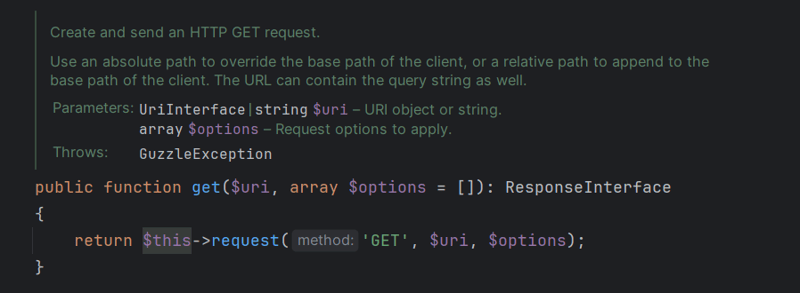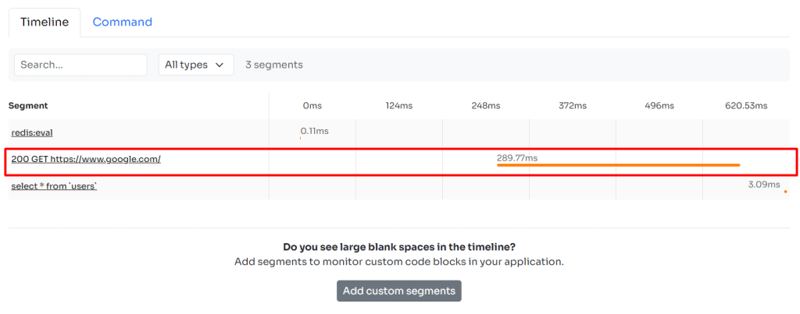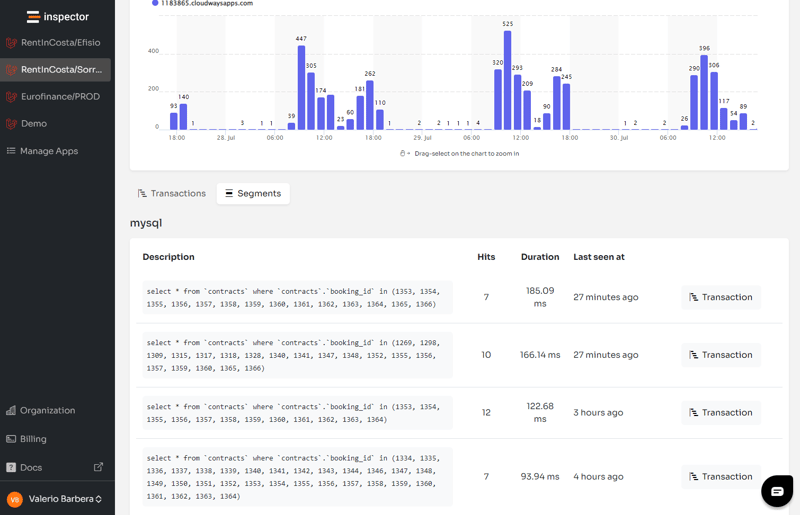How to monitor Guzzle Http Client – PHP Fast tips
Guzzle is a popular PHP HTTP client that makes it easy to send HTTP requests and create web service libraries. The most popular PHP frameworks provides an internal Http Client service, and they are simply a customized implementation of the Guzzle Http Client:
- Laravel Http Client
- Symfony Http Client
- Laminas (formerly Zend Framework) Http Client
Guzzle is widely used for two main reasons:
1) Customization and Flexibility
For the fans of design patterns Guzzle is open to extensions. Means that you can easily implement new functionalities into Guzzle by extending its core components (Http Client, Request, Response, Milddeware, etc).
2) Support for Middleware
The Guzzle middleware system allows developers to interact with a Request before it is sent, and Response before they are processed. It can enable advanced features like logging, authentication, and error handling.
Introduction to Guzzle HTTP Client
In this tutorial, I will guide you through the process of creating a custom Guzzle Http Client to make it easy to monitor every request made from your application against external services.
I will also show you how to inject this implementation into the IoC container (or Services Container) to make this implementation available throughout your application.
We will cover the basics, customization options, and provide real code examples.
Install Guzzle
Ensure you have Guzzle installed. If not, install it using Composer:
composer require guzzlehttp/guzzle
Basic Customization
Let's start by creating a basic custom Guzzle Http Client:
namespace App\Extensions\Guzzle;
use GuzzleHttp\Client;
class CustomGuzzleClient extends Client
{
public function __construct(array $config = [])
{
$config['headers']['Custom-Header'] = 'Custom-Value';
parent::__construct($config);
}
}
In this example, we extend the Guzzle Http Client class and customize the constructor to add a custom header to all requests made by this client.
Monitor Guzzle Http Requests
Guzzle provides shortcut methods to run Http requests:
$client->get('/endpoint');
$client->post('/endpoint');
$client->put('/endpoint');
All of these methods use the generic request method inside. The screenshot below was taken from the Guzzle Client code:

You can override the request method to customize the management of HTTP calls made by your application to external services.
namespace App\Extensions\Guzzle;
use GuzzleHttp\Client;
use GuzzleHttp\Exception\RequestException;
class CustomGuzzleClient extends Client
{
public function request($method, $uri, array $options = [])
{
return inspector()->addSegment(function () use ($method, $uri, $options) {
return parent::request($method, $uri, $options);
}, "http", "{$method} {$uri}");
}
}
In this example I just add a new item in the transaction’s timeline for every request. Now you can see the API calls made by Guzzle in your monitoring view:

If you are new to Inspector you can follow this tutorial on how to get started:
https://inspector.dev/laravel-real-time-performance-monitoring-using-inspector-part-1/
You can also inject the Segment parameter in the callback to interact with the item or add more information:
namespace App\Extensions\Guzzle;
use GuzzleHttp\Client;
use GuzzleHttp\Exception\RequestException;
use Inspector\Models\Segment;
class CustomGuzzleClient extends Client
{
public function request($method, $uri, array $options = [])
{
return inspector()->addSegment(function (Segment $segment) use ($method, $uri, $options) {
$response = parent::request($method, $uri, $options);
$segment->label = "{$response->getStatusCode()} {$method} {$uri}";
return $response;
}, "http");
}
}
Use the custom Http Client
Now, you can use your custom client in your application. Since the extension doesn't introduce any change to the behavior of the standard Guzzle Http Client, you can make an instance of the custom class and use it as usual:
// Create an instance of the custom client
$client = new CustomGuzzleClient(['base_uri' => 'https://api.example.com']);
// Make an API request. It will be automatically monitored by Inspector.
$response = $client->get('/endpoint');
Bind the Guzzle Http Client into the container
I'm going to use Laravel in this example, but the basic concept is the same for the most popular PHP frameworks mentioned at the beginning of the article. All of them work with a Service Container.
We create a singleton binding into the container for the Guzzle Http Client class. So every service that ask for this class will receive an instance of our custom client that supports real-time monitoring.
use GuzzleHttp\Client;
use App\Extensions\Guzzle\CustomGuzzleClient;
use Illuminate\Contracts\Foundation\Application;
$this->app->singleton(Client::class, function (Application $app) {
return new CustomGuzzleClient();
});
Now you can try to inject the Guzzle Http Client class in an Artisan Command and run an Http call just for testing:
namespace App\Console\Commands;
use Illuminate\Console\Command;
use GuzzleHttp\Client;
class TryCommand extends Command
{
/**
* The name and signature of the console command.
*
* @var string
*/
protected $signature = 'try';
/**
* The console command description.
*
* @var string
*/
protected $description = 'Test Guzzle Http Client monitoring.';
/**
* Inject the Guzzle Http Client class into the constructor.
* The CustomGuzzleClient will be the concrete class.
*/
public function __construct(protected Client $client)
{
parent::__construct();
}
/**
* Handle the command execution.
*/
public function handle()
{
$this->line($this->description);
$this->line("Concrete class: ".get_class($this->client));
$this->client->get('https://google.com');
return Command::SUCCESS;
}
}
Run the command to verify if the Http Call will be visible in the transaction's timeline:
php artisan try
New To Inspector? Monitor your application for free
Inspector is a Code Execution Monitoring tool specifically designed for software developers. You don't need to install anything in your cloud infrastructure or servers, just install the composer package and you are ready to go.
Unlike other complex, all-in-one platforms, Inspector is super easy, and PHP friendly. You can try our Laravel or Symfony package.
If you are looking for effective automation, deep insights, and the ability to forward alerts and notifications into your messaging environment try Inspector for free. Register your account.
Or learn more on the website: https://inspector.dev

The above is the detailed content of How to monitor Guzzle Http Client – PHP Fast tips. For more information, please follow other related articles on the PHP Chinese website!

Hot AI Tools

Undresser.AI Undress
AI-powered app for creating realistic nude photos

AI Clothes Remover
Online AI tool for removing clothes from photos.

Undress AI Tool
Undress images for free

Clothoff.io
AI clothes remover

Video Face Swap
Swap faces in any video effortlessly with our completely free AI face swap tool!

Hot Article

Hot Tools

Notepad++7.3.1
Easy-to-use and free code editor

SublimeText3 Chinese version
Chinese version, very easy to use

Zend Studio 13.0.1
Powerful PHP integrated development environment

Dreamweaver CS6
Visual web development tools

SublimeText3 Mac version
God-level code editing software (SublimeText3)

Hot Topics
 1664
1664
 14
14
 1422
1422
 52
52
 1316
1316
 25
25
 1267
1267
 29
29
 1240
1240
 24
24
 PHP and Python: Comparing Two Popular Programming Languages
Apr 14, 2025 am 12:13 AM
PHP and Python: Comparing Two Popular Programming Languages
Apr 14, 2025 am 12:13 AM
PHP and Python each have their own advantages, and choose according to project requirements. 1.PHP is suitable for web development, especially for rapid development and maintenance of websites. 2. Python is suitable for data science, machine learning and artificial intelligence, with concise syntax and suitable for beginners.
 Explain secure password hashing in PHP (e.g., password_hash, password_verify). Why not use MD5 or SHA1?
Apr 17, 2025 am 12:06 AM
Explain secure password hashing in PHP (e.g., password_hash, password_verify). Why not use MD5 or SHA1?
Apr 17, 2025 am 12:06 AM
In PHP, password_hash and password_verify functions should be used to implement secure password hashing, and MD5 or SHA1 should not be used. 1) password_hash generates a hash containing salt values to enhance security. 2) Password_verify verify password and ensure security by comparing hash values. 3) MD5 and SHA1 are vulnerable and lack salt values, and are not suitable for modern password security.
 PHP in Action: Real-World Examples and Applications
Apr 14, 2025 am 12:19 AM
PHP in Action: Real-World Examples and Applications
Apr 14, 2025 am 12:19 AM
PHP is widely used in e-commerce, content management systems and API development. 1) E-commerce: used for shopping cart function and payment processing. 2) Content management system: used for dynamic content generation and user management. 3) API development: used for RESTful API development and API security. Through performance optimization and best practices, the efficiency and maintainability of PHP applications are improved.
 What are HTTP request methods (GET, POST, PUT, DELETE, etc.) and when should each be used?
Apr 09, 2025 am 12:09 AM
What are HTTP request methods (GET, POST, PUT, DELETE, etc.) and when should each be used?
Apr 09, 2025 am 12:09 AM
HTTP request methods include GET, POST, PUT and DELETE, which are used to obtain, submit, update and delete resources respectively. 1. The GET method is used to obtain resources and is suitable for read operations. 2. The POST method is used to submit data and is often used to create new resources. 3. The PUT method is used to update resources and is suitable for complete updates. 4. The DELETE method is used to delete resources and is suitable for deletion operations.
 PHP: A Key Language for Web Development
Apr 13, 2025 am 12:08 AM
PHP: A Key Language for Web Development
Apr 13, 2025 am 12:08 AM
PHP is a scripting language widely used on the server side, especially suitable for web development. 1.PHP can embed HTML, process HTTP requests and responses, and supports a variety of databases. 2.PHP is used to generate dynamic web content, process form data, access databases, etc., with strong community support and open source resources. 3. PHP is an interpreted language, and the execution process includes lexical analysis, grammatical analysis, compilation and execution. 4.PHP can be combined with MySQL for advanced applications such as user registration systems. 5. When debugging PHP, you can use functions such as error_reporting() and var_dump(). 6. Optimize PHP code to use caching mechanisms, optimize database queries and use built-in functions. 7
 Explain the difference between self::, parent::, and static:: in PHP OOP.
Apr 09, 2025 am 12:04 AM
Explain the difference between self::, parent::, and static:: in PHP OOP.
Apr 09, 2025 am 12:04 AM
In PHPOOP, self:: refers to the current class, parent:: refers to the parent class, static:: is used for late static binding. 1.self:: is used for static method and constant calls, but does not support late static binding. 2.parent:: is used for subclasses to call parent class methods, and private methods cannot be accessed. 3.static:: supports late static binding, suitable for inheritance and polymorphism, but may affect the readability of the code.
 How does PHP handle file uploads securely?
Apr 10, 2025 am 09:37 AM
How does PHP handle file uploads securely?
Apr 10, 2025 am 09:37 AM
PHP handles file uploads through the $\_FILES variable. The methods to ensure security include: 1. Check upload errors, 2. Verify file type and size, 3. Prevent file overwriting, 4. Move files to a permanent storage location.
 How does PHP type hinting work, including scalar types, return types, union types, and nullable types?
Apr 17, 2025 am 12:25 AM
How does PHP type hinting work, including scalar types, return types, union types, and nullable types?
Apr 17, 2025 am 12:25 AM
PHP type prompts to improve code quality and readability. 1) Scalar type tips: Since PHP7.0, basic data types are allowed to be specified in function parameters, such as int, float, etc. 2) Return type prompt: Ensure the consistency of the function return value type. 3) Union type prompt: Since PHP8.0, multiple types are allowed to be specified in function parameters or return values. 4) Nullable type prompt: Allows to include null values and handle functions that may return null values.




